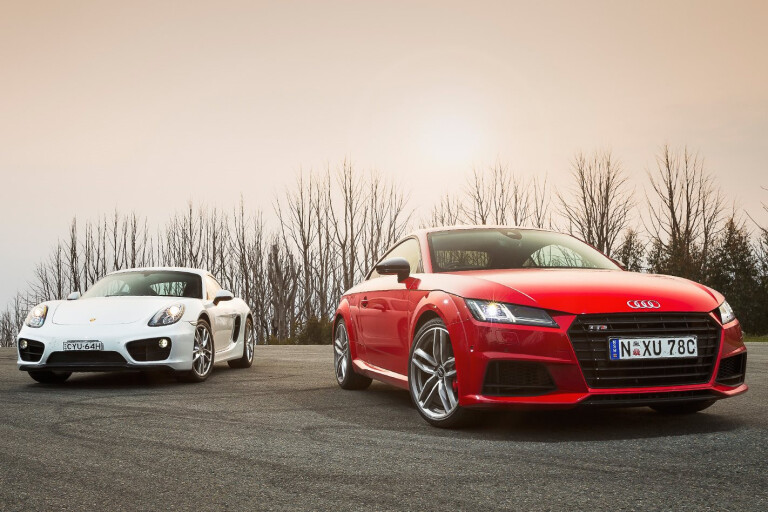
It’s high time we built another ark, only this one will be filled with garages, not animal pens.
A flood of battery-powered semiautonomous vehicles is on the horizon and we must preserve the finest examples of the fast car species for the enjoyment of future generations. Just which model from each segment deserves to be stashed away would make for excellent pub fodder, however here we have two circa-$100K sports cars fighting for the honour of driving up the gangplank.
For all their similarities in price and positioning, the Audi TT S and Porsche Cayman differ greatly in their mechanical make-up. The Cayman is the more traditional of the two, with a free-breathing, high-revving 2.7-litre flatsix engine wedged midships driving the rear wheels.
Porsche’s entry-level coupe starts at $106,200, the addition of the seven-speed PDK gearbox and 19-inch Boxster S wheels lifting our test car’s price to $113,900.
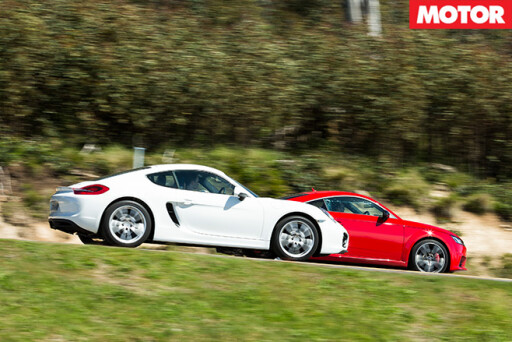 In standard guise the $99,900 TT S holds a handy price advantage, but Audi options are plentiful. Metallic paint adds $1400, leather another $800, but the big ticket items are the $6300 ‘S performance package’ – 19-inch 10-spoke matt titanium alloys, LED headlights, Nappa leather, Bang & Olufsen surround sound stereo and silver interior highlights – and the $1900 assistance package, which as the name suggests adds various driver assistance items such as heated exterior mirrors and high-beam and park assist. Finally, an extra $1100 buys the ‘black high gloss exterior package’ for a grand total of $111,400.
In standard guise the $99,900 TT S holds a handy price advantage, but Audi options are plentiful. Metallic paint adds $1400, leather another $800, but the big ticket items are the $6300 ‘S performance package’ – 19-inch 10-spoke matt titanium alloys, LED headlights, Nappa leather, Bang & Olufsen surround sound stereo and silver interior highlights – and the $1900 assistance package, which as the name suggests adds various driver assistance items such as heated exterior mirrors and high-beam and park assist. Finally, an extra $1100 buys the ‘black high gloss exterior package’ for a grand total of $111,400.
Underneath the evolutionary styling the TT S is most definitely a product of the 21st century. A turbocharged 2.0-litre four-cylinder sits over the front axle feeding all four wheels through a six-speed dualclutch ’box. Aussie cars are robbed of 11kW compared to their Euro counterparts, but 210kW/380Nm is still enough to shift 1385kg with haste. Launch control primed, the TT S will reel off 4.7sec/12.9sec passes all day long, its best run netting 0-100km/h in 4.68sec and a 12.95sec quarter mile at 173.65km/h.
Before you get too carried away with your drag strip prowess, however, consider this. For curiosity’s sake, we conducted a real-world acceleration run without launch control and the results were eye-opening. Simply flooring the accelerator from standstill added 1.2sec to the Audi’s 0-100km/h time and by 170km/h it was 1.9sec down.
 No matter which way you cut the deck, though, it’s vastly superior to the Cayman in a straight line, despite the two sharing identical power-to-weight ratios. Extremely tall gearing exaggerates the Porsche’s torque deficit – it’s produces 90Nm less across a much narrower rev band – and even impeccably calibrated launch control can’t make the Cayman any faster than 5.80sec to 100km/h and a 13.93sec quarter mile at 163.38km/h. Impressive numbers 10 years ago, now they barely pass muster on a mid-spec hot hatch.
No matter which way you cut the deck, though, it’s vastly superior to the Cayman in a straight line, despite the two sharing identical power-to-weight ratios. Extremely tall gearing exaggerates the Porsche’s torque deficit – it’s produces 90Nm less across a much narrower rev band – and even impeccably calibrated launch control can’t make the Cayman any faster than 5.80sec to 100km/h and a 13.93sec quarter mile at 163.38km/h. Impressive numbers 10 years ago, now they barely pass muster on a mid-spec hot hatch.
But while this is not a particularly fast car, the way the flat-six delivers its 202kW/290Nm makes it one of the world’s greatest engines. It’s murdered by the Audi for in-gear punch – 80-120km/h in fifth takes 8.0sec in the Cayman versus 5.2sec in the TT S – but that’s simply an excuse to use a lower gear and let it scream out to its 7800rpm change-up point. And it’s not like it labours at low rpm; it’s perfectly happy trundling along at suburban speeds in sixth or seventh gear.

Extended to the redline, the soundtrack is raw and raucous and the linearity and response of the atmo flat-six still can’t be replicated by a turbocharged engine, at least not with current technology. Of course, by the middle of 2016 this sublime engine will be gone, replaced by a turbo four-pot, however while it’ll no doubt make the new 718 Cayman (see p14) a faster car, Porsche’s engineers are going to have a hard time making it a more enjoyable one.
The Cayman’s greatest flaw is undoubtedly its gearing. It would be questionably tall attached to a 7.0-litre V8 – second gear stretches to 134km/h, third to 186km/h – so a torque-lite 2.7-litre is always going to struggle to pull with conviction. No doubt it helps ease the passage through restrictive emissions testing, but when the PDK ’box is able to disconnect drive on the highway and ‘sail’ along in neutral you have to question the real-world fuel economy benefits.
 Porsche’s standard shift method is still a faff (each side of the steering wheel has a toggle: press forward to shift up, click back to shift down, both sides do the same thing; or just pay extra for proper paddles) but the gearbox itself – doppelkupplungsgetriebe for your next trivia night – is superb, with largely impeccable stop-start manners, instant shifts and a scarily intuitive sport mode. It’s just a shame you can’t exercise it as often as you’d like.
Porsche’s standard shift method is still a faff (each side of the steering wheel has a toggle: press forward to shift up, click back to shift down, both sides do the same thing; or just pay extra for proper paddles) but the gearbox itself – doppelkupplungsgetriebe for your next trivia night – is superb, with largely impeccable stop-start manners, instant shifts and a scarily intuitive sport mode. It’s just a shame you can’t exercise it as often as you’d like.
It’s a similar situation in the TT S, albeit for a very different reason. It has six shortly-stacked ratios in the dual-clutch ’box, which is both faster-shifting and better behaved than ever, however the breadth of the 2.0-litre turbo’s power delivery means that you don’t need to shift very often. Leave it in third and the Audi will pull out of all but the tightest of hairpins with little hesitation. There is some lag right down low but beyond that it revs strongly from peak torque at 1800rpm to peak power at 6200rpm.
 Initially, it feels little more potent than the regular TT. A peek at the spec sheets reveals why, the lesser sibling packing only 10Nm fewer than the S. The extra grunt is all at the top end and not a bit is wasted thanks to quattro all-wheel drive. Audi is keen to point out that the latest Haldex system can send 100 per cent of the power to the rear wheels, however the TT S is no power oversteerer.
Initially, it feels little more potent than the regular TT. A peek at the spec sheets reveals why, the lesser sibling packing only 10Nm fewer than the S. The extra grunt is all at the top end and not a bit is wasted thanks to quattro all-wheel drive. Audi is keen to point out that the latest Haldex system can send 100 per cent of the power to the rear wheels, however the TT S is no power oversteerer.
There’s occasionally a hint of power understeer in tricky turns but more often than not it will tighten its line under power as torque vectoring nips the inside wheels to keep the nose on line. In corners the TT S displays a level of athleticism not often found in products with four rings on the nose. There’s plenty of outright grip, but the balance is also easily manipulated; carry the brakes into a corner and the rear edges wide but there’s never a hint that it will let go completely.
 It’s a friendly chassis, inspiring confidence so that soon you’re using that rear-end agility to corner in little four-wheel drifts rather than just leaning on the nose. Sports ESP allows plenty of leeway for the car to move around and, unlike many Audis, selecting Dynamic for the steering lends it reasonable weight without turning it into a wooden, syrupy mess.
It’s a friendly chassis, inspiring confidence so that soon you’re using that rear-end agility to corner in little four-wheel drifts rather than just leaning on the nose. Sports ESP allows plenty of leeway for the car to move around and, unlike many Audis, selecting Dynamic for the steering lends it reasonable weight without turning it into a wooden, syrupy mess.
It’s a polished dynamic performance, but unfortunately the TT S completely drops the ball in terms of ride quality. It’s not the firmness that’s the problem – the Cayman is equally firm – but rather the way it jars over sharp bumps, fidgets over smaller ones and crashes into potholes, leaving the occupants feeling battered and bruised. From memory it’s not a problem that afflicts the standard TT, so there’s a suspicion this behaviour is engineered-in to justify the ‘S’ badge, however it could partly be a result of rubber. Our test car wears Hankooks and fellow tester Louis – who attended the TT Roadster launch – remembers Continental-equipped cars being slightly more comfortable. Still, the spec presented is what we have to assess and the result is unacceptable.

The Cayman quickly delivers a lesson in how a sports car should ride. It’s firm but well-controlled and most of the time feels to work with the road rather than fight against it. It’s no limousine, and optioning PASM adaptive dampers might improve things even further, but the standard set-up is a fine compromise between comfort and road-holding. With slower steering than the Audi’s variable-rate rack, the Cayman can initially feel a little ponderous on turn-in but once you dial in it’s just sublime.
Even by Porsche’s high standards the Cayman stands out as special. Perhaps the steering doesn’t offer quite the clarity of the old 987’s hydraulic setup, but it’s beautifully weighted – heavy at low speeds then freeing up as pace increases – and its linear responses allow you to pour into turns, the Cayman flowing through a series of bends like liquid mercury.
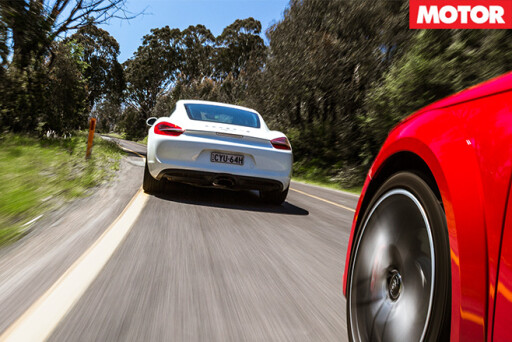 It also has that unique Porsche quality of feeling better the harder you drive it; whereas the TT S (and most other cars, to be honest) begin to wilt at the edge of the envelope the Cayman laps up your commitment.
It also has that unique Porsche quality of feeling better the harder you drive it; whereas the TT S (and most other cars, to be honest) begin to wilt at the edge of the envelope the Cayman laps up your commitment.
It’s so good that after a while I don’t even mind the PDK shift arrangement.
The only slight foible is its ESP calibration. Press the skids button and ‘PSM off’ is displayed, however should the car start to slide the telltale light on the dash begins to flash. But here’s the weird part: stay committed to the throttle and you can hang the tail out to your heart’s content with seemingly no intervention. So is it on or off? Not sure, but we suspect the new 991.2 991’s Sport Mode ESP will migrate to the 718 Cayman to allow on-road playtime.
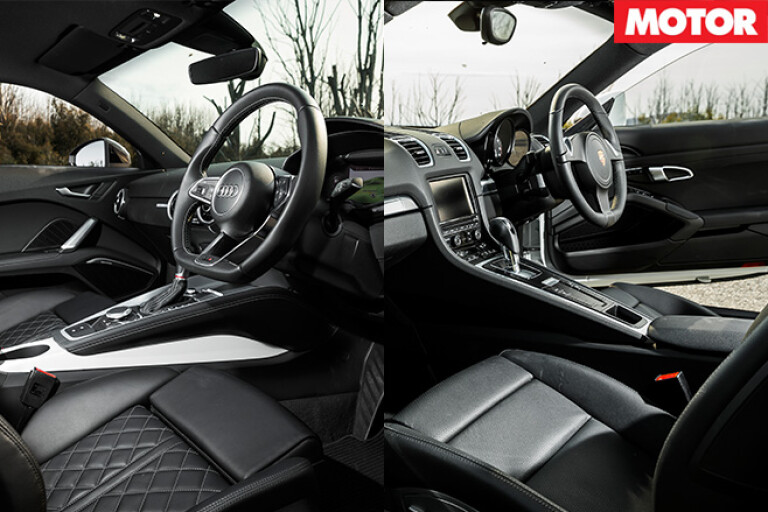
Both cars’ driving positions are spot-on with plenty of adjustment, however while the Cayman’s driver-focused cockpit is functional, well-made and contains all the equipment you need, it can’t match the minimalist masterpiece that is the TT S interior.
Its Bentley-esque diamond-quilted leather, aircraftlike row of switches and swish circular air vents with digital displays in the centre make it feel special, though following sat-nav instructions on Audi’s very clever digital instrument display does seem to take your attention off the road for longer than a traditional centre screen.
Obviously, looks are a huge part of the purchasing decision with cars like these, but equally so subjective that which is better is primarily down to personal taste – Louis thinks the Cayman looks bland, whereas I think it looks sensational. The TT S looks virtually identical to its lesser-powered sibling – it’ll take trainspotters to pick the S badges and quad exhaust pipes – and while understatement has a certain appeal, should there be greater visual differentiation to justify the $22,000 price premium?
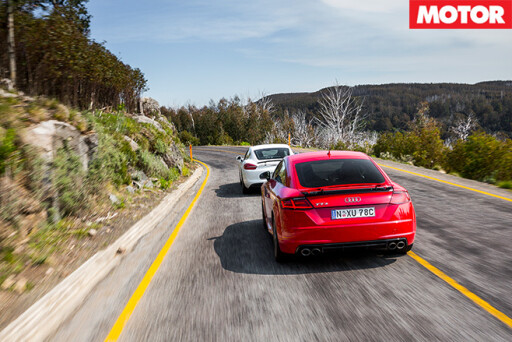 That’s a question only buyers can answer, and they will find plenty to like in the new TT S. Quick, classy and an entertaining drive, this is now a very capable sports car, easily capable of dismissing any ignorant ‘hairdresser’ jibes. It’s just a shame that having come so close to excellence, the TT S is let down by its abysmal ride – it’s like Audi baked a delicious cake and then smothered it in Vegemite. There’s also the nagging question of diminishing returns; when the regular TT is so good, the S struggles to make a case for itself somewhat.
That’s a question only buyers can answer, and they will find plenty to like in the new TT S. Quick, classy and an entertaining drive, this is now a very capable sports car, easily capable of dismissing any ignorant ‘hairdresser’ jibes. It’s just a shame that having come so close to excellence, the TT S is let down by its abysmal ride – it’s like Audi baked a delicious cake and then smothered it in Vegemite. There’s also the nagging question of diminishing returns; when the regular TT is so good, the S struggles to make a case for itself somewhat.
The question of diminishing returns also raises its head in regards to the Cayman, but this time in its favour. When the base model is this good, why would you spend extra on an S or GTS (the GT4 is a different animal entirely)? They offer more speed, but little extra involvement or enjoyment. There’s a temptation to look down your nose at a base Cayman, but it’s a simply brilliant sports car, which is why it’s being welcomed aboard the good ship MOTOR.
| Porsche Cayman | Audi TT S | |
| Body | 2-door, 2-seat coupe | 2-door, 2+2-seat coupe |
| Drive | rear-wheel | all-wheel |
| Engine | 2706cc flat-six, DOHC, 24v | 1984cc inline-4, DOHC, 16v, turbo |
| Bore/Stroke | 89.0 x 72.5mm | 82.5 x 92.8mm |
| Compression | 12.5:1 | 9.3:1 |
| Power | 202kW @ 7400rpm | 210kW @ 5300-6200rpm |
| Torque | 290Nm @ 4500-6500rpm | 380Nm @ 1800-5200rpm |
| Power/weight | 152kW/tonne | 152kW/tonne |
| Transmission | 7-speed dual-clutch | 6-speed dual-clutch |
| Weight | 1330kg | 1385kg |
| Suspension(f) | struts, A-arms, coil springs, anti-roll bar | struts, A-arms, adaptive dampers, coil springs, anti-roll bar |
| Suspension(r) | multi-links, coil springs, anti-roll bar | multi-links, coil springs, adaptive dampers, anti-roll bar |
| L/W/H | 4380/1801/1294mm | 4191/1832/1343mm |
| Wheelbase | 2475mm | 2505mm |
| Tracks | 1526/1536mm (f/r) | 1574/1553mm (f/r) |
| Steering | electrically-assisted rack-and-pinion | electrically-assisted rack-and-pinion |
| Brakes(f) | 315mm ventilated/drilled discs, 4-piston calipers | 338mm ventilated discs, 4-piston calipers |
| Brakes(r) | 299mm ventilated/drilled discs, 4-piston calipers | 310mm ventilated discs, single-piston calipers |
| Wheels | 19.0 x 8.0-inch (f); 19 x 9.5-inch (r) | 19.0 x 8.0-inch (f/r) |
| Tyres | 235/40 ZR19 (f); 265/35 ZR19(r) | 245/35 ZR19 (f/r) |
| Tyre | Goodyear Eagle F1 | Hankook Ventus S1 Evo |
| Price | $113,900 | $111,400 |
| Positives | Almost everything – one of the world's best sports cars | Punchy engine; playful, involving handling; great interior |
| Negatives | Tall gearing; shift paddles cost extra; flat-six about to die | Dreadful ride quality; is it $20K-plus better than the base TT? |
| Star Rating | 4.5 | 3.5 |

COMMENTS